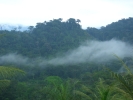
The Atiwa rainforest in southeastern Ghana is one of West Africa’s greatest natural treasures. Its varied ecosystems have given rise to a trove of exceptional biodiversity – lush jungle with eight-meter tree ferns, marshes and river landscapes that are a refuge for Africa’s rarest animals and plants. A total of 260 square kilometers of Atiwa have been declared a protected area. Yet the forest is not only rich in life, but also in minerals. Atiwa has significant bauxite deposits that the government intends to mine – unlike national parks, protected areas are not safe from exploitation.
“Our forests shall be sold off to mining companies and will then be turned into open pits without heed for the priceless natural resources we depend on,” writes Daryl Bosu of A Rocha Ghana, an environmental NGO. The Atiwa forest supplies five million people with drinking water. Forest dwellers rely on it for food, medicine, building materials, tools and clothing. The forest also provides protection against floods and drought.
In recent years, several multinational companies have obtained prospecting licenses. “Yet the negotiations are not open and transparent,” Bosu notes, fearing that the government will one day confront the Ghanaian people with established facts.
There is still time for action. A Rocha Ghana has joined forces with several groups opposed to mining in the Coalition of NGOs Against Mining in Atiwa (CONAMA). The coalition is calling on Ghana’s government to protect the entire Atiwa rainforest against all forms of exploitation and declare it a national park. Rainforest Rescue is asking to sign a petition to protect the Atiwa forest.


